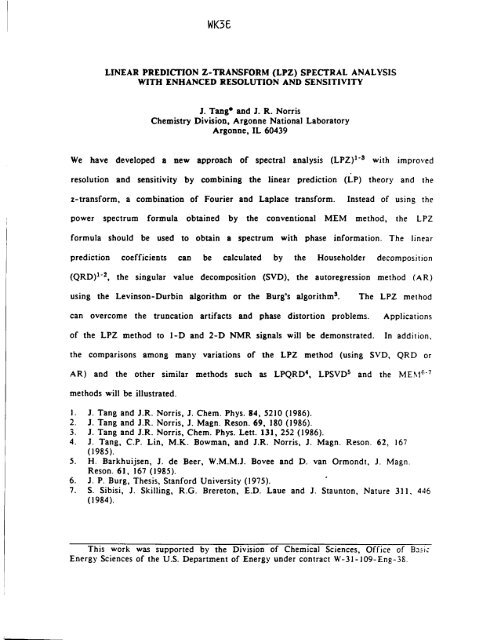th - 1987 - 51st ENC Conference
th - 1987 - 51st ENC Conference
th - 1987 - 51st ENC Conference
You also want an ePaper? Increase the reach of your titles
YUMPU automatically turns print PDFs into web optimized ePapers that Google loves.
WK3C<br />
LINEAR PREDICTION Z-TRANSFORM (LPZ) SPECTRAL ANALYSIS<br />
WITH ENHANCED RESOLUTION AND SENSITIVITY<br />
J. Tang* and J. R. Norris<br />
Chemistry Division, Argonne National Laboratory<br />
Argonne, IL 60439<br />
We have developed a new approach of spectral analysis (LPZ) l"s wi<strong>th</strong> improved<br />
resolution and sensitivity by combining <strong>th</strong>e linear prediction (l~P) <strong>th</strong>eory and <strong>th</strong>e<br />
z-transform, a combination of Fourier and Laplace transform. Instead of using <strong>th</strong>e<br />
power spectrum formula obtained by <strong>th</strong>e conventional MEM me<strong>th</strong>od, <strong>th</strong>e LPZ<br />
formula should be used to obtain a spectrum wi<strong>th</strong> phase information. The linear<br />
prediction coefficients can be calculated by <strong>th</strong>e Householder decomposition<br />
(QRD) 1-~, <strong>th</strong>e singular value decomposition (SVD), <strong>th</strong>e autoregression me<strong>th</strong>od (AR)<br />
using <strong>th</strong>e Levinson-Durbin algori<strong>th</strong>m or <strong>th</strong>e Burg's algori<strong>th</strong>m s. The LPZ me<strong>th</strong>od<br />
can overcome <strong>th</strong>e truncation artifacts and phase distortion problems. Applications<br />
of <strong>th</strong>e LPZ me<strong>th</strong>od to I-D and 2-D NMR signals will be demonstrated. In addition,<br />
<strong>th</strong>e comparisons among many variations of <strong>th</strong>e LPZ me<strong>th</strong>od (using SVD, QRD or<br />
AR) and <strong>th</strong>e o<strong>th</strong>er similar me<strong>th</strong>ods such as LPQRD 4, LPSVD s and <strong>th</strong>e ME..M 6"7<br />
me<strong>th</strong>ods will be illustrated.<br />
1. J. Tang and J.R. Norris, J. Chem. Phys. 84, 5210 (1986).<br />
2. J. Tang and J.R. Norris, J. Magn. Reson. 69, 180 (1986).<br />
3. J. Tang and J.R. Norris, Chem. Phys. Lett. 131, 252 (1986).<br />
4. J. Tang, C.P. Lin, M.K. Bowman, and J.R. Norris, J. Magn. Reson. 62, 167<br />
(1985).<br />
5. H. Barkhuijsen, J. de Beer, W.M.M.J. Bovee and D. van Ormondt, J. Magn.<br />
Reson. 61, 167 (1985).<br />
6. J.P. Burg, Thesis, Stanford University (1975).<br />
7. S. Sibisi, J. Skilling, R.G. Brereton, E.D. Laue and J. Staunton, Nature 311, a46<br />
(1984).<br />
This work was supported by <strong>th</strong>e Division of Chemical Sciences, Office of B~_~ic<br />
Energy Sciences of <strong>th</strong>e U.S. Department of Energy under contract W-31-109-Eng-38.













